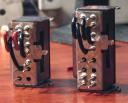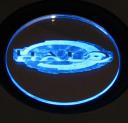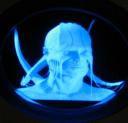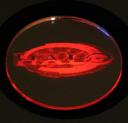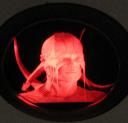Years ago a good friend of mine turned me on to a great card game called Killer Bunnies. I instantly fell in love with the game and like most of my hobbies I decided to actively collect all the different expansions and rarities associated with it. The starter box holds a number of cards and Dice and had room to spare for 2 or 3 of the expansion packs. Past that I purchased 4 more expansions but never used them, simply because they wouldn’t fit in the box and carrying a whole stack of boxes around with you when visiting friends and family is rather cumbersome. Not to mention using the starter box you had to be creative when putting the game away to ensure that everything fit.
For months I looked for a reasonable case, poker cases were nice but they only held a small number of cards and the rest of the space was dedicated to chips, not easily modified either. Card cases for baseball collectors were either cheap cardboard boxes that held cards en-masse for storage or books where the cards were made be looked at rather then used. Even card holders for other games were almost always emblazoned with logos and artwork dedicated to that game (like Pokémon or Yugi-oh). I eventually found a company called Vanguard who makes cases for photo equipment. The cases are nice looking sturdy and contain half-cut foam cubes that you can remove to appropriately store your equipment. Most of the cases were too thin or small for what I needed but I finally found a case with a depth appropriate to fit cards, the Vanguard VGP-3202.
Removing a few foam peaces you can easily create rectangular shapes just popping out foam with your hands. Each foam square is 1/2 inch by 1/2 inch and there are 2 depths, half way down the case and all the way down the case. (~2 3/4 inches total depth)
After determining the layout I wanted to use I removed all the appropriate foam pieces and did a test fit. I was careful to nail down the layout before I started and not break-off any foam that I didn’t intend to. I suppose I could have tried to glue some of it back on if I made a mistake but luckily that didn’t happen.
now that I have the cards in it would seem that the lid requires pressure to close completely. This would be find if I was using it to hold camera equipment but I’d rather not put pressure across the cards. They have a slight amount of pressure across them horizontally and that holds them in place, I would imagine vertical pressure from the uneven foam lid could potentially cause damage to the cards down the road.
Checking the depth of the lid’s foam with a needle there is more then enough space for the lid to close comfortably if I remove the foam. Carefully pulling the foam out and testing this proves correct. But now I have a different problem.
The glue used on the lid is some nasty stuff, breaking out my trusty Goo-Gone (never failed me in the past) only seemed to make it worse! After scrubbing at it for a half hour and wasting nearly a quarter bottle of goo-gone to no avail i decided it might be best to cover it up. The walls of the case are covered with a a thin foam material similar to what you might find in a crafts store. Off to Walmart down the street I picked up 2 sheets of foam for 48 cents a piece, even better the foam has a peel and stick backing, so I wont even have to break out the spray adhesive. While I was there I had the idea to affix an envelope to the lid to hold the manuals. Now that the original egg-carton foam has been removed there is ample head-room for the game manuals. So picked up some envelopes while I was there.
A single sheet of the foam covered the base of the lid perfectly covering up the bulk of the ugliness.
Unfortunately there was some glue spillage from the original foam on the walls as well so using a razor blade (and a scrap 2×4 as a backer to protect my desk) I cut some strips out of the second piece of foam and re-covered the inside walls of the lid
Once the lid was completely lined in fresh foam I put an envelope down for a test fit. I specifically went for a square flapped envelope as opposed to a triangle cut. I also have enough foam left over that I’ll be able to cover the envelope once it’s in palace.
I peel off the backing from the remaining foam sheet and center the envelop with the bottom aligned along once edge. I then cut off a bit of the envelope’s top so it’s the same size as the foam. The foam should hold it in palace once installed but to keep from accidentally putting the manuals BEHIND the envelope as opposed to IN the envelope I placed a thin strip of electrical tape along the back edge of the envelop that will create a smooth connection between the lid and the envelope making it easier to open the pocket and slide in papers.
Once that’s done the case is ready for use, and holds all the current decks as well as leaving space for the future installments
I’m very please with how the case turned out, it’s portable and durable and holds everything current and future which is exactly what I was looking for. Since it was originally intended as a camera case it has locks on the latches which is also very beneficial considering the card collection inside is easily worth over $100.
























